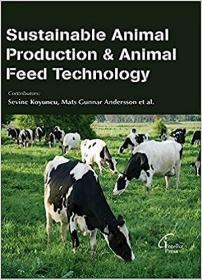
现货Sustainable Animal Production & Animal Feed Technology[9781682511633]
¥ 1434 九五品
仅1件
作者Sevinc Koyuncu,?Mats Gunnar Andersson
出版社Intelliz Press LLC
ISBN9781682511633
出版时间2016-01
装帧精装
纸张其他
正文语种英语
上书时间2023-08-08
- 最新上架
商品详情
- 品相描述:九五品
- 商品描述
- Animal production plays an important role in most small-scale farming systems throughout the world. They provide traction to cultivate fields, manure to maintain crop productivity, and nutritious food products for human consumption and income-generation. Despite the importance of livestock, inadequate livestock nutrition is a common problem in the developing world, and a major factor affecting the development of viable livestock industries in poor countries. Because of the growing demand for animal feed, new technologies and techniques need to be continuously developed and transferred in order to avoid environmental deterioration or increases in the prices of food products. Research and technology generation seeking ways to overcome food insecurity and poverty are therefore essential for agricultural and rural development. Sustainable Animal Production & Animal Feed Technology emphasizes on trends and technologies in animal production and feeding. The aims of first chapter are to investigate: the efficacy of FA, PA and commercial mixtures of organic acids for reduction in Salmonella in feed materials; the variation in acid tolerance among Salmonella strains isolated from feed; whether lower temperatures reduced the decontamination by acids compared to room temperature. The aim of second chapter is to synthesize and expand upon existing data on the contribution of farm animal production to climate change. Third chapter is written to highlight the necessity and potential of using the de-fatted microalgal biomass as a new generation of animal feed in helping address the global energy, food, and environmental issues. The objective of fourth chapter is to evaluate the occurrence and levels of deoxynivalenol (DON), fumonisins B1 and B2 (FBs), and zearalenone (ZEN) contaminants in animal feeds used in Korea in 2012. Contamination with DON was observed in 91.33% and 53.33% in compound feeds and feed ingredients, respectively. Fifth chapter focuses on antibiotic growth promoters enhance animal production by targeting intestinal bile salt hydrolase and its producers. In sixth chapter, we review recent initiatives to leverage data routinely observed by farmers, production managers, veterinary practitioners, diagnostic laboratories, regulatory officials, and slaughterhouse inspectors for disease surveillance purposes. The objective of seventh chapter is to evaluate pre-screened Bacillus strain for use as an in-feed probiotic for newly weaned pigs in comparison to a control treatment without antibiotic or pharmacological levels of zinc oxide (non-medicated treatment) and a positive control treatment containing apramycin and pharmacological levels of zinc oxide (medicated treatment). The objectives of eighth chapter are to investigate the effects of adding corn DDGS to the dairy cow diet as well as the bedding types (wood shavings, straw or peat moss) on manure fugitive CH4 emissions. Ninth chapter provides the characteristics of the conventional high input (C-HI), conventional low input (C-LI), and organic low input (O-LI) pasture-based production systems used in Southern Brazil, and its consequences on production and milk quality. The aim of tenth chapter are to determine the effect of rearing systems for pig production, as concerns performance, meat lipid content, the fatty acid profile, histidinic antioxidants, coenzyme Q10, and TBARs. The main objective of eleventh chapter is to obtain scientifically sound data on the bioenergy potential of dairy manures from cows fed different levels of corn dried distillers grains with solubles (DDGS). Twelfth chapter examines available evidence of the influence of epigenetic marks on livestock (cattle, sheep, goat, and pig) traits and discusses the potential for considera?tion of epigenetic markers in livestock improvement programs. Thirteenth chapter aims to determine the ruminal degradability of DM and NDF, both in vitro and in situ, on forages and fibrous byproducts using ruminal liquor of goats. Ruminal acidosis in feedlot has been presented in fourteenth chapter. Fifteenth chapter considers on the use of exogenous fibrolytic enzymes to improve forage utilization. Sixteenth chapter deals with developing a process for bioconversion of wheat straw into a digestible and nutrient rich animal feed with a selective lignin degrading fungus, Crinipellis sp. RCK-1, grown under solid-state fermentation for 5 days. Seventeenth chapter reveals the different gene expression patterns or pathways related to the endometrium remodeling in Meishan and Yorkshire pigs, respectively. Eighteenth chapter focuses on how the pasture rule has impacted the management, economics and nutritional value of products derived from organic ruminant systems and the interactions of grazing cattle with pasture forages and soils. Last chapter focuses on the future of pork production in the world.
相关推荐
-
![现货Labour Mobility: An Enabler for Sustainable Development[9789948147367]](https://www0.kfzimg.com/sw/kfz-cos/kfzimg/17733071/0c6e06ab2be0babd_s.jpg)
现货Labour Mobility: An Enabler for Sustainable Development[9789948147367]
九五品上海
¥ 212.00
-
![现货Intrinsic Capability: Implementing Intrinsic Sustainable Development for an Ecological Civilisation[9789813225572]](https://www0.kfzimg.com/sw/kfz-cos/kfzimg/17733071/f3984c521b7c4feb_s.jpg)
现货Intrinsic Capability: Implementing Intrinsic Sustainable Development for an Ecological Civilisation[9789813225572]
九五品上海
¥ 918.00
-
![现货 Construction, Demolition and Disaster Waste Management: An Integrated and Sustainable Approach[9781498768214]](https://www0.kfzimg.com/sw/kfz-cos/kfzimg/17733071/16333db059d98209_s.jpg)
现货 Construction, Demolition and Disaster Waste Management: An Integrated and Sustainable Approach[9781498768214]
九五品上海
¥ 1463.00
-

SOUTHEAST ASAN WISDOM STORIES FOR SUSTAINABLE DEVELOPMENT (An Anthology)
九品商丘
¥ 9.40
-
![现货 Sustainable Aviation (2019)[9783030141943]](https://www0.kfzimg.com/sw/kfz-cos/kfzimg/17733071/4cee12e5efc9a0fd_s.jpg)
现货 Sustainable Aviation (2019)[9783030141943]
九五品上海
¥ 891.00
-
![现货 Sustainable Design Basics[9781119443735]](https://www0.kfzimg.com/sw/kfz-cos/kfzimg/17733071/635295ea10ff26a7_s.jpg)
现货 Sustainable Design Basics[9781119443735]
九五品上海
¥ 779.00
-
![现货Sustainable Process Engineering[9783110717129]](https://www0.kfzimg.com/sw/kfz-cos/kfzimg/17733071/1d642981b323f674_s.jpg)
现货Sustainable Process Engineering[9783110717129]
九五品上海
¥ 656.00
-

Sustainable Protein Sources 进口原版现货
九五品信阳
¥ 748.00
-
![现货 Elements of Sustainable Architecture[9780815367826]](https://www0.kfzimg.com/sw/kfz-cos/kfzimg/17733071/a78c4229db3be1d4_s.jpg)
现货 Elements of Sustainable Architecture[9780815367826]
九五品上海
¥ 1161.00
-
![现货Nanotechnology in Sustainable Agriculture[9780367369408]](https://www0.kfzimg.com/sw/kfz-cos/kfzimg/17733071/c681f4ecd16cc46f_s.jpg)
现货Nanotechnology in Sustainable Agriculture[9780367369408]
九五品上海
¥ 1823.00
— 没有更多了 —
![现货Sustainable Animal Production & Animal Feed Technology[9781682511633]](https://www0.kfzimg.com/sw/kfz-cos/kfzimg/17733071/7e4e43dc6082c989_b.jpg)

![现货Materials and Technologies of Modern Production[9783036401683]](https://www0.kfzimg.com/sw/kfz-cos/kfzimg/17733071/5fd2824531e165d7_s.jpg)
![现货Introduction to Container Ship Operations and Onboard Safety[9781032155425]](https://www0.kfzimg.com/sw/kfz-cos/kfzimg/17733071/58b7ff43ef7909ee_s.jpg)
![现货Electrophosphorescent Materials and Devices[9789814877343]](https://www0.kfzimg.com/sw/kfz-cos/kfzimg/17733071/18cc1d77bcb7b488_s.jpg)
![现货Organic Semiconductors for Optoelectronics[9781119146100]](https://www0.kfzimg.com/sw/kfz-cos/kfzimg/17733071/24c85a750c708964_s.jpg)
![现货Advances in Food Rheology and Its Applications[9780081004319]](https://www0.kfzimg.com/sw/kfz-cos/kfzimg/17733071/e0c11603c9119d4d_s.jpg)
![现货Advanced Materials and Sustainable Technologies[9783035727562]](https://www0.kfzimg.com/sw/kfz-cos/kfzimg/17733071/dced675333874c48_s.jpg)
![现货Advanced Materials and Manufacturing Engineering II[9783035712681]](https://www0.kfzimg.com/sw/kfz-cos/kfzimg/17733071/660ccfae75fa8d3e_s.jpg)
![现货Materials in Machinery and Construction[9783035718119]](https://www0.kfzimg.com/sw/kfz-cos/kfzimg/17733071/6f402060775e9daa_s.jpg)
![现货Cereal Grain Quality (Softcover Reprint of the Original 1st 1996)[9789401071772]](https://www0.kfzimg.com/sw/kfz-cos/kfzimg/17733071/f93ca1c96a97403a_s.jpg)
![现货Sustainable Animal Production & Animal Feed Technology[9781682511633]](/dist/img/error.jpg)
以下为对购买帮助不大的评价